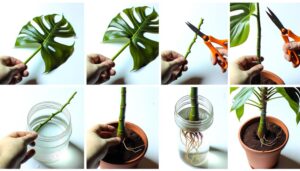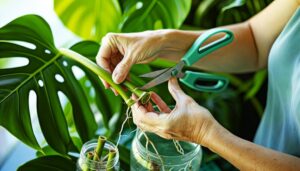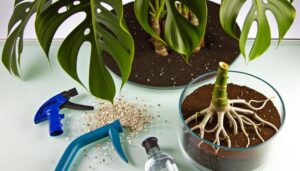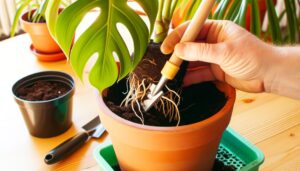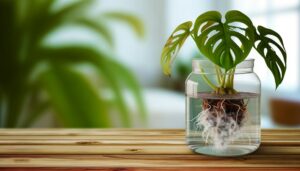Monstera Propagation in Water Turning Yellow: Solutions Tips
If your Monstera propagation is turning yellow, it’s likely due to nutrient deficiencies, water quality issues, or inadequate light. Use distilled or filtered water to avoid tap water impurities like chlorine and heavy metals.
Make sure the cutting receives indirect sunlight, as direct exposure can cause leaf scorch. Incorporate a balanced water-soluble fertilizer to address potential nitrogen, iron, or magnesium deficiencies.
Maintain ideal water conditions by regularly changing it to prevent fungal infections and using sanitized tools. Interested in more in-depth strategies and the final steps for successful transplantation?
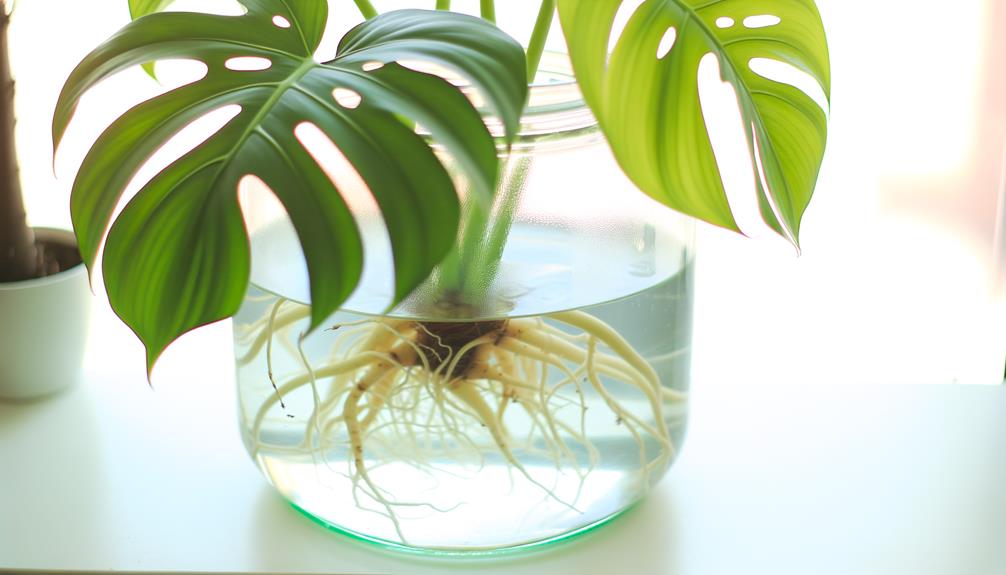
Key Takeaways
- Ensure adequate indirect light to prevent etiolation and leaf burn in propagated Monstera cuttings.
- Regularly change the water and use filtered or distilled water to avoid impurities and maintain root health.
- Monitor for nutrient deficiencies, particularly nitrogen and iron, and use balanced water-soluble fertilizers when necessary.
- Sanitize propagation tools and containers to prevent fungal infections and reduce pathogen risks.
- Maintain consistent water temperature and avoid temperature fluctuations that can stress the plant and cause yellowing.
Common Causes of Yellowing
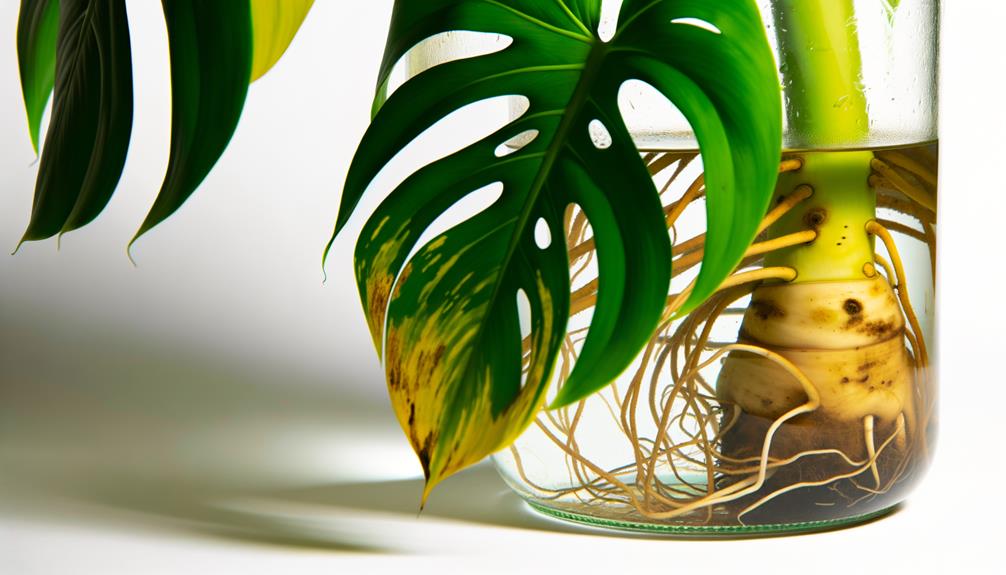
Several factors can cause the yellowing of Monstera cuttings during water propagation.
- First, nutrient deficiency is a primary reason. Without sufficient nutrients, the cuttings can’t sustain healthy chlorophyll levels, leading to chlorosis.
- Second, temperature fluctuations can stress the plant. Monstera cuttings thrive in stable, warm environments. Drastic temperature changes impair metabolic processes, causing yellowing.
- Third, inadequate light can lead to etiolation. Monstera cuttings require indirect, bright light for ideal photosynthesis.
- Fourth, overexposure to direct sunlight can scorch the leaves, resulting in yellowing.
- Finally, pests or pathogens can compromise the plant’s health. Aphids, spider mites, and fungal infections can all cause yellow leaves.
Water Quality and Its Impact
Beyond the common causes of yellowing, the quality of water used for Monstera propagation greatly impacts the plant’s health and growth. Tap water often contains chlorine, fluoride, and heavy metals, which can hinder root development and cause leaf discoloration. Using distilled or filtered water reduces these impurities.
Additionally, monitor the water’s pH level; Monsteras prefer slightly acidic to neutral pH (5.5 to 7). Regularly change the water to prevent stagnation and bacterial growth, both of which can harm the roots. Guarantee the water temperature is consistent with the ambient environment, as extreme temperatures can stress the plant.
Light Conditions for Propagation
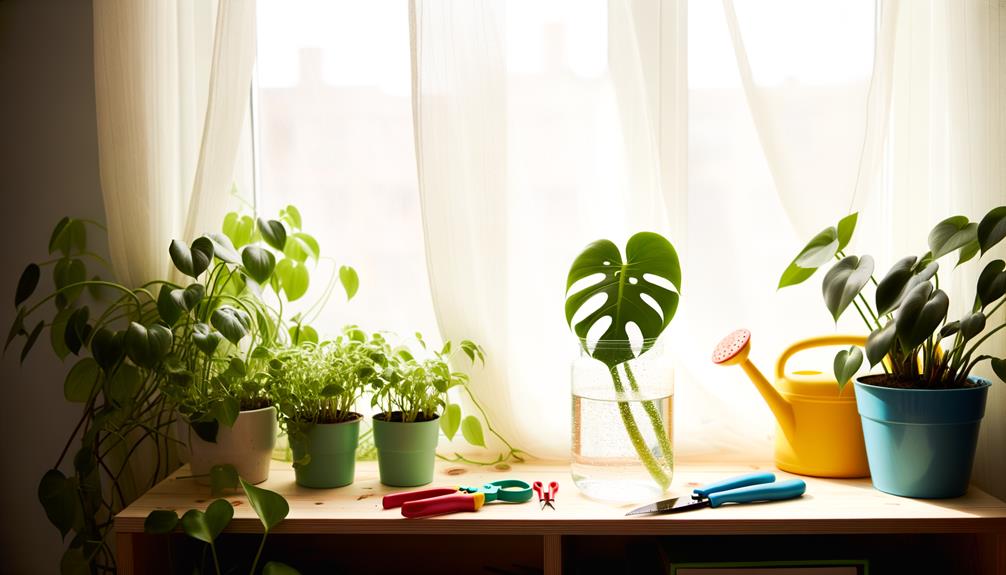
When propagating Monstera in water, you need to maintain ideal light levels to prevent yellowing. Indirect sunlight promotes healthy root development and minimizes stress on the cuttings.
Avoid placing the container in direct sunlight, as it can cause leaf burn and worsen nutrient imbalances.
Optimal Light Levels
Guaranteeing ideal light levels is crucial for the successful propagation of Monstera cuttings in water. Peak light conditions directly impact root development and overall plant health. Aim to provide bright, indirect light to replicate the plant’s natural habitat.
Follow these specific guidelines to achieve success:
- Light Intensity: Position your Monstera cuttings where they receive 2000-2500 foot-candles of light. Use a light meter for precision.
- Duration: Maintain a consistent photoperiod of 12-14 hours per day using supplemental grow lights if needed.
- Light Source: Utilize full-spectrum LED grow lights to imitate natural sunlight, ensuring uniform light distribution without generating excess heat.
Implementing these strategies will improve root growth and prevent yellowing in Monstera cuttings.
Indirect Sunlight Benefits
Indirect sunlight provides the best light conditions for propagating Monstera cuttings, as it mimics their native tropical environment and prevents stress-induced yellowing.
In these conditions, light intensity is diffused, reducing the risk of photoinhibition and photodamage to chloroplasts. This guarantees optimal photosynthetic activity without excessive exposure to harsh rays, promoting healthy root development and chlorophyll synthesis.
Position your cuttings near a north or east-facing window, using sheer curtains if necessary to filter the light. Studies show that indirect light exposure enhances cellular respiration rates and nutrient uptake, crucial for young cuttings.
Monitoring light levels with a light meter can guarantee they remain within the ideal range of 100-200 foot-candles, fostering vigorous growth without compromising plant health.
Avoiding Direct Sunlight
Exposing your Monstera cuttings to direct sunlight can lead to photodamage, chlorophyll degradation, and consequently, yellowing of the leaves. Direct sunlight increases the intensity of ultraviolet (UV) radiation, which damages the plant cells.
To prevent this, make sure your cuttings receive adequate but indirect light.
Here’s how you can optimize light conditions:
- Filter sunlight: Use sheer curtains to diffuse incoming light.
- Positioning: Place the cuttings a few feet away from windows that receive direct sunlight, ensuring they get bright, indirect light.
- Artificial lighting: Utilize grow lights equipped with full-spectrum LED bulbs to simulate natural light without the harmful UV radiation.
Nutrient Deficiencies
Nutrient deficiencies in your Monstera propagation can cause the leaves to turn yellow due to a lack of essential minerals such as nitrogen, iron, or magnesium. Insufficient nitrogen impairs chlorophyll synthesis, leading to chlorosis.
Iron deficiency disrupts the formation of chloroplast proteins, resulting in interveinal yellowing. Magnesium, a central component of chlorophyll, when deficient, causes leaf edges to yellow while veins remain green.
Utilize a balanced, water-soluble fertilizer to rectify these deficiencies. Regularly monitor the hydroponic solution’s pH, ensuring it remains between 5.5 and 6.5 for optimal nutrient absorption.
Employing a complete nutrient solution can mitigate these issues, promoting healthier, greener foliage. Accurate diagnosis and targeted intervention are fundamental for maintaining the vitality of your Monstera propagation.
Preventing Fungal Infections
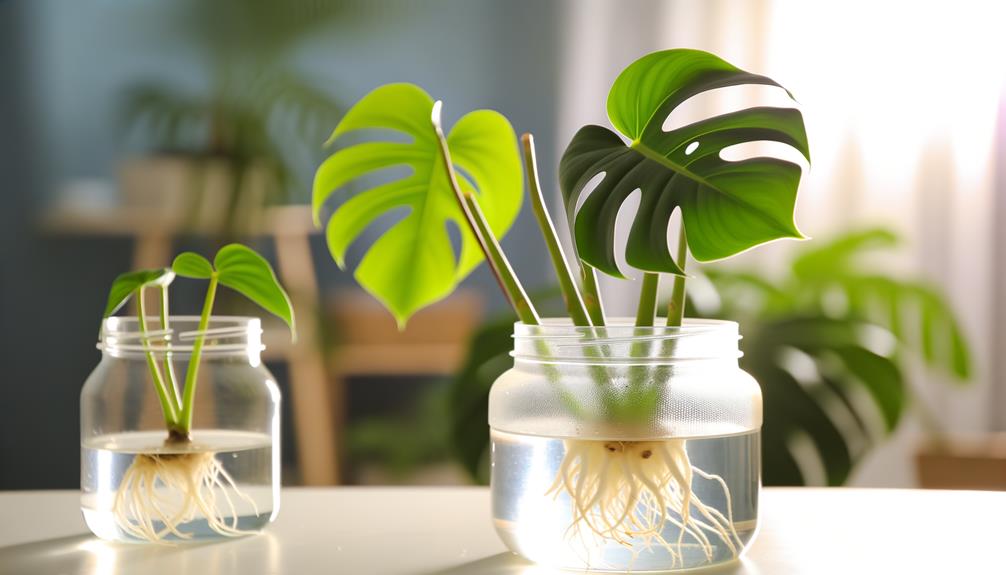
To prevent fungal infections during Monstera propagation, you should regularly change the water to reduce pathogen load. Additionally, always sanitize propagation tools with a disinfectant solution to eliminate potential fungal spores.
Research indicates these practices greatly lower the risk of fungal contamination, ensuring healthier cuttings.
Sanitizing Propagation Tools
Properly sanitizing your propagation tools is crucial for preventing fungal infections and promoting healthy Monstera cuttings. Contaminated tools can transfer pathogens, compromising plant health.
Follow these steps to sanitize effectively:
- Disinfecting Solution: Use a 10% bleach solution or 70% isopropyl alcohol to wipe down your scissors, knives, or pruning shears. This kills most bacteria and fungi.
- Sterilization: Heat tools in boiling water for at least 30 minutes. This process eradicates any remaining spores or microorganisms.
- Regular Cleaning: After each use, clean tools with soap and water, then disinfect. This minimizes the risk of cross-contamination between plants.
These practices promote healthy Monstera cuttings, supporting ideal growth.
Changing Water Regularly
Maintaining clean water is necessary for preventing fungal infections and ensuring your Monstera cuttings remain healthy during propagation. You should change the water every 3-4 days to inhibit microbial growth. Use distilled or filtered water to reduce contamination risk. Regular water changes keep oxygen levels ideal, which is vital for root development.
| Frequency | Water Type | Benefits |
|---|---|---|
| Every 3-4 days | Distilled | Reduces contaminants |
| Every 3-4 days | Filtered | Maintains oxygen levels |
| Weekly | Tap (treated) | Less ideal but acceptable |
| As needed | Rainwater | Natural, but variable |
Neglecting this practice can lead to yellowing leaves and stunted growth due to fungal infections. Monitor water clarity and odor, acting promptly to maintain a sterile environment for your cuttings.
Best Practices for Healthy Cuttings
Ensuring your Monstera cuttings remain healthy involves selecting disease-free stems, using sterilized tools, and maintaining best water conditions.
First, choose a robust stem with at least one node and aerial root, as these are crucial for successful propagation.
Second, use sanitized scissors or a knife to prevent bacterial or fungal infections.
Lastly, keep the water clean and oxygenated by changing it every 3-5 days.
To summarize:
- Select disease-free stems: Guarantee no visible signs of disease or pest infestation.
- Use sanitized tools: Sterilize scissors or knives with rubbing alcohol before cutting.
- Maintain ideal water conditions: Change water regularly and ensure proper aeration.
Following these steps enhances the likelihood of healthy root development.
Conclusion
To wrap up, you’ve learned that yellowing in water-propagated Monstera cuttings often stems from poor water quality, inadequate light, nutrient deficiencies, or fungal infections.
By maintaining ideal water conditions, ensuring sufficient light, and providing necessary nutrients, you can promote healthy growth.
Remember, healthy cuttings are your first line of defense against these issues. Implement these best practices diligently, and you’ll see your Monstera thrive.
Don’t let yellowing discourage you—it’s a solvable problem with the right care.

